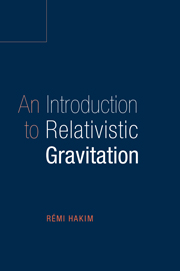Book contents
- Frontmatter
- Contents
- Preface
- 1 NEWTONIAN GRAVITATION
- 2 MINKOWSKI SPACE–TIME
- 3 THE RELATIVISTIC FORM OF PHYSICAL LAWS
- 4 GRAVITATION AND SPECIAL RELATIVITY
- 5 ELECTROMAGNETISM AND RELATIVISTIC HYDRODYNAMICS
- 6 WHAT IS CURVED SPACE?
- 7 THE PRINCIPLE OF EQUIVALENCE
- 8 EINSTEIN'S RELATIVISTIC GRAVITATION (GENERAL RELATIVITY)
- Appendix A Tensors
- Appendix B Exterior Differential Forms
- Appendix C Variational Form of the Field Equations
- Appendix D The Concept of a Manifold
- References
- Physical Constants
8 - EINSTEIN'S RELATIVISTIC GRAVITATION (GENERAL RELATIVITY)
Published online by Cambridge University Press: 05 June 2012
- Frontmatter
- Contents
- Preface
- 1 NEWTONIAN GRAVITATION
- 2 MINKOWSKI SPACE–TIME
- 3 THE RELATIVISTIC FORM OF PHYSICAL LAWS
- 4 GRAVITATION AND SPECIAL RELATIVITY
- 5 ELECTROMAGNETISM AND RELATIVISTIC HYDRODYNAMICS
- 6 WHAT IS CURVED SPACE?
- 7 THE PRINCIPLE OF EQUIVALENCE
- 8 EINSTEIN'S RELATIVISTIC GRAVITATION (GENERAL RELATIVITY)
- Appendix A Tensors
- Appendix B Exterior Differential Forms
- Appendix C Variational Form of the Field Equations
- Appendix D The Concept of a Manifold
- References
- Physical Constants
Summary
We have seen in the preceding chapters that the changes in the theory of gravity introduced by relativity, chiefly as a consequence of the famous relation E = mc2 (Chapter 4), amount to the near-necessity of introducing curved space-time, also a consequence of the Equivalence Principle (Chapters 6 and 7). However, this principle does not specify the equations determining the ten components of the metric tensor gµv. The relation E = mc2 suggests that these equations must be non-linear (Chapter 4). In this chapter we shall study the simplest equations compatible with observation, and show how they arise. These are Einstein's equations, and the theory they define is called general relativity. We shall derive some elementary consequences which are astrophysically important.
The curvature of space–time expresses the effects of gravitation on physical phenomena through a metric tensor gµv, which cannot be reduced to ηµv everywhere. However, this does not rule out the existence of other long-range fields which might also be important. The theory of C. Brans and R.H. Dicke (1961) is the best-known example; here a scalar field coexists with the metric tensor. The existence of such fields must ultimately be decided by experiment or observation [see C. Will (1981)]. Currently it appears that the metric tensor alone appears capable of ensuring agreement with observation, and that general relativity is the correct relativistic theory of gravity.
We note again that simple arguments rule out relativistic theories of gravity based solely on a scalar or vector field.
- Type
- Chapter
- Information
- An Introduction to Relativistic Gravitation , pp. 187 - 226Publisher: Cambridge University PressPrint publication year: 1999



